Posted in Blog, Design Thinking, Innovation, Innovation Culture, Lead, Lead Your Team, Virtual Facilitation by Jo North
Leading collaboration in remote teams
Leading collaboration in remote teams is all about creating an environment and culture for effective team working when co-workers are based in different locations and need to fulfil at least a significant proportion of their work together, usually online.
How do you build collaboration between people in remote teams?
This article takes a realistic, human view of how remote team collaboration can feel and work in business, and is filled with actionable tips insights that you can use in the leadership of your own team. It will help you to:
- Have a deeper understanding of the nature and benefits of collaboration
- Know when to collaborate – and when not to!
- Consider your role as an effective leader of remote team collaboration
- Be mindful and intentional in your leadership approach by using and developing the emotional intelligence skills of you and your team
- Differentiate between co-operation and collaboration
- Promote the multiplier effect that effective collaboration has on team performance
- Instil principles of successful collaboration, including the role of psychological safety, insights from Google’s Project Aristotle and the latest research on remote team working
- Understand the importance of leadership role-modelling
- Build successful relationships in an online environment
- Foster healthy challenge within the team – showing you how to challenge others constructively, and be open to positive challenge yourself
- Lead effectively when collaboration gets tough, in the knowledge that it’s more important than ever to keep collaboration high at these times
Leading collaboration in remote teams – leadership skills
I have been facilitating Leading Remote Collaboration programmes for businesses well before the events of 2020 and 2021. Of course, when the pandemic struck, more and more business leaders wanted and needed to learn new skills to help them to get their teams working effectively together to achieve and sustain high levels of performance through lockdown.

I wanted to share some of the key themes, tips and insights from the programme here in this article so that you and your team can benefit from them too.
I really hope that you find my article useful and interesting, and if you’d like to more I’m always happy to meet up with you virtually over a coffee or tea – please do get in touch via the ‘contact us’ form below,
What is remote collaboration?
A definition of remote collaboration is two or more people working together towards shared goals from different locations, usually online.
Benefits of leading collaboration in remote teams
We know from research, as well as from our experience, that when collaboration works brilliantly we get improved engagement, more efficiency and processes are stronger.
Other benefits of collaboration, when it is done well, are that it:
- Provides people with the space and stimuli for more innovation and creativity
- Generates business creativity
- Reduces risk
- Enriches decision-making, via a diversity of perspectives
- Enhances people’s communication and negotiation skills
- Builds sustainable relationships
- Saves time, effort and money through efficient working
- Develops a range of skills and competencies
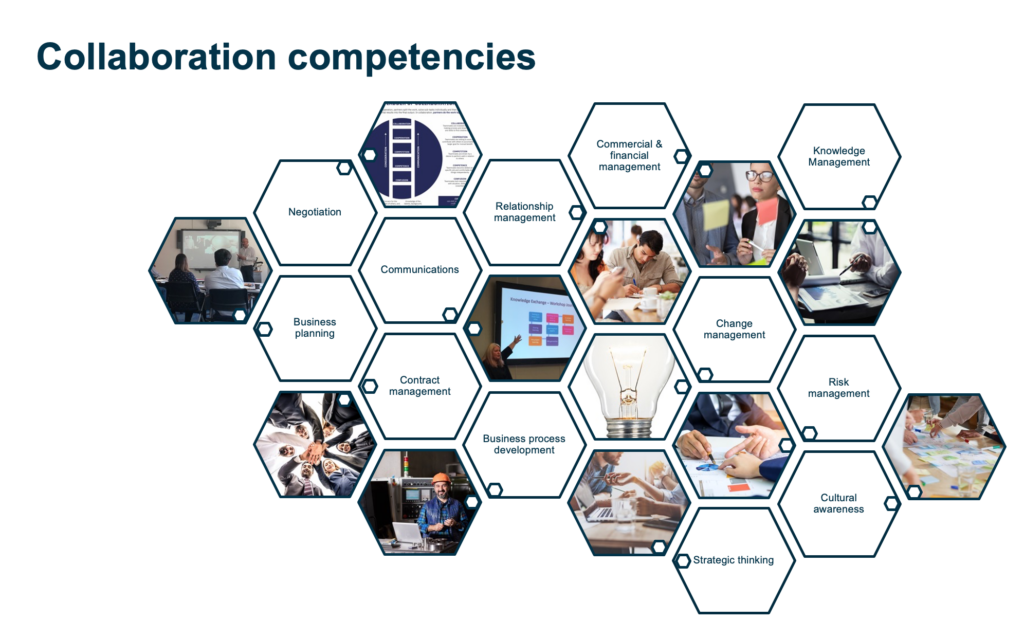
When NOT to collaborate
Research shows that there are times when collaboration is appropriate and times when it isn’t. Sometimes it really is more efficient to just let different experts get on and do what they do best.
Collaboration for collaboration’s sake definitely doesn’t work!

It is better NOT to collaborate when:
- It’s not necessary for everyone to be involved, or even in agreement. Sometimes we can over-egg our desire to be inclusive of the full team, so being clear on when inclusivity matters and when it doesn’t – and getting your team’s take on that – will definitely help.
- You have an idea or project that you want people to buy into. If you just want the team to agree with and say ‘yes’ to your idea, it’s much better to share it with them directly and use your influencing skills to communicate with them, instead of trying to fly with some sort of pseudo-collaboration activity. Just be straight with them. You can still engage and get buy-in without having to dance around trying to get everyone else to think it was their idea in the first place.
- When different people or parties have very different, competing or even conflicting agendas, negotiation and co-operation is a more realistic and helpful route than collaboration would be.
- If a task or project is pretty straightforward, team members with the skills to do it should just be able to crack on with it and get it done.
Individuals perform better than the group as a whole
It is a myth that a group thinks better than the individuals who make up the group. In fact, people think better on their own. It’s a really good idea to give people time for individual reflection before you all get together for a brainstorm or team discussion. Individual inputs will be greater and better quality, and you’ll have a richer and more useful session together.
Emotional intelligence and collaboration
Collaboration requires skill, and one of those skills is emotional intelligence.
Emotional intelligence is the capacity to be aware of, control, and express one’s emotions, and to handle interpersonal relationships judiciously and empathetically.
It’s important that we use our emotional intelligence when we’re collaborating and that the group is an emotionally intelligent group of people.
It helps when people understand how they themselves are feeling and how those feelings are affecting their behaviors, decisions and actions, choosing to change those feelings where they might be unhelpful.
Being mindful, self-aware and intentional about their own feelings helps individuals to have empathy for, and connect with, other people in the team. And of course, when collaboration gets tough, that’s when everyone really does need to dial up those emotional intelligence skills.

The importance of leadership role-modeling collaboration in remote teams
As leaders we need to be mindful and intentional about collaboration.
It’s our job to foster and nurture an environment where great collaboration between everyone can thrive.
We need to ensure that we have an environment where collaboration can take place. We should also be mindful that we are always role-modeling. People watch to see how you, as their leader, handles situations. They intentionally or subconsciously take their cues from how they see you behaving.
A good leader
A good leader ensures that every person in the team is crystal-clear about the three elements shown below in my Collaboration Triangle, i.e. task, relationships, processes.

It’s your role, as the leader of a remote team, to ensure that your each of your team members fully understands:
- Why they’re in the team, the role that they play and the importance of their contribution
- The purpose and scope of the collaboration
- Where does the collaboration start?
- And where does it end?
- The processes, systems, governance, tools, approaches, values and behaviors that keep the collaboration running smoothly.
Building successful relationships in an online environment
Collaboration is all about relationships. People may think that collaboration is happening simply when we work together. That may be collaborative and cooperative, but it’s not necessarily true collaboration.
Building healthy, collaborative relationships requires optimistic points of view as well as being generous and forgiving. You also need to be assertive, confident and challenging.
Ladder of collaboration
I’ve asked the question “Is it collaboration, if we all get on well, together?”. Not necessarily!
“In cooperation, partners split the work, solve sub-tasks individually and then assemble the partial results into the final output. In collaboration, partners do the work together.”
Pierre Dillenbourg (1995) University of Geneva, Switzerland
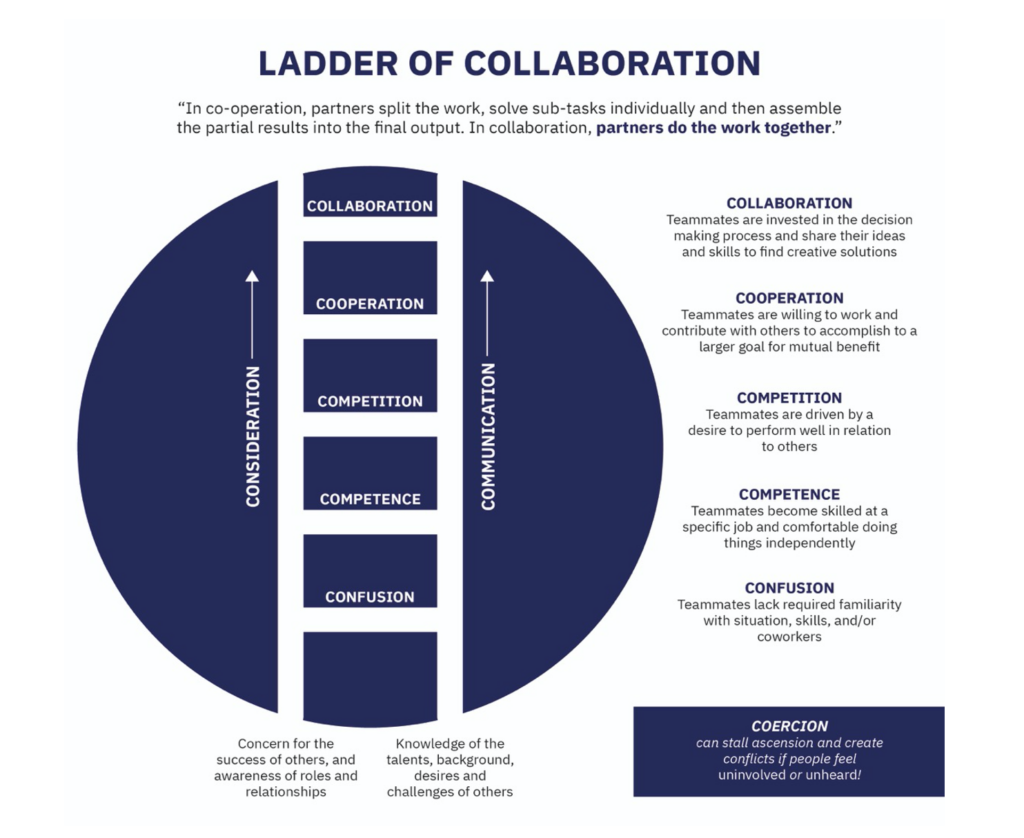
The visual above shows the Ladder of Collaboration (inspired by Himmeman, 2002, and R.Hart, 1997).
While we’re going to start at the bottom of the Ladder of Collaboration, I do want to point out that you don’t have to start at the bottom and go up the steps sequentially to arrive at collaboration at the top. You can come in at any point in this ladder. We, however, are going to start at the bottom and work our way up for the purposes of this explanation.
- Coercion is where somebody is made to do something. This is not collaboration; we’re just issuing an instruction.
- Confusion is where people have a sense that they think they should be working together, but they’re not sure why and they’re not sure who’s doing what, so it’s all a bit loose and messy.
- Competence is where people are good at what they do, and they like to do it independently.
- Cooperation is where people in the team are happy to help each other as needed, but not at the level of true collaboration.
- Collaboration is where the team comes together to find creative solutions, shape things together, consult and jointly decide on the best way forward.

We are all above average (apparently!) – the Dunning-Kruger effect
The Dunning–Kruger effect is a type of cognitive bias in which people believe that they are smarter and more capable than they really are. It’s also known as the above average effect, or better than average effect.
In workshops I ask people to place a virtual pin or sticky note to show where they think they are in the context of their team working on the ladder of collaboration.
I then ask them to place a second pin or sticky note to indicate which rung they think other team members are on.
In the vast majority of cases – and I have repeated this exercise with literally hundreds of delegates in different sectors – the individual ‘ranking’ is notably higher that the perceived team ‘ranking’.
The Dunning-Kruger effect is alive and well in teams!
To paraphrase Mary McCarthy, we are each the hero in our own story. Without even realising it, we are probably also the baddie in someone else’s!
Because we see situations from our own perspective, we can more easily justify our own position and actions than we can those of another person, especially when it’s someone we are not keen on, or with whom we disagree. This is where those emotional intelligence skills really come into their own. To truly collaborate we need to see perspectives of others almost as objectively as we can see our own, and empathize with their position.
Remember that to empathize is not the same as to agree. We can see someone else’s point of view without having to agree with it.

Remote team collaboration
Many organizations have discovered the advantages and disadvantages of remote team collaboration, as I have found in my Leading Remote Collaboration sessions with delegates around the world.
Advantages of effective remote team collaboration
- High employee satisfaction, engagement and retention
- Access to a wider talent pool
- The ability for greater diversity and inclusion within teams
- Greater productivity
- Lower costs
Disadvantages of remote team collaboration
- Difficulty building relationships, often due to a lack of social contact
- Communication challenges, because we do not pick up as many nonverbal cues from team mates as we can when we’re in the same room
- Decreased employee visibility, meaning that it’s hard to see what others are working on
- The challenge ensuring people aren’t working either too much or even too little
- Employee work-life balance, with many people feeling that they always need to be connected, especially in businesses that operate across multiple time zones
Hybrid team collaboration
Hybrid teams bring additional challenges and opportunities. To help with this, have a look at my Guide to Hybrid Working for Teams here, and How to Run Hybrid Meetings and Workshops here.
Leadership challenges of collaboration in online meetings
One of the biggest challenges that my workshop participants seek out my help for how to encourage honesty and openness in their online team meetings.
Many leaders find that some people seem reluctant to speak out in a remote setting. As leaders, we need to role-model to people that they are safe to speak out and be themselves.
Leaders have also asked me to to help them with questions such as these:
- Can we be as effective as when we’re face to face?
- Can we be a good leader from a distance? If so, what does that look like?
- How do we know people are really working / aren’t working too much?
- How can we make our online meetings more engaging, and avoid people just tuning out.
Booking virtual coffees and one-to-ones with individual team members is key. Listen attentively. Ask people about how they are doing, not just about the task-elements of the work that they do, and go beyond superficial niceties. Be genuinely interested, and you will answer these questions for yourself naturally. Please do be fully present for your team members. Avoid distractions from alerts and phone calls, and make that time fully about them.
To make your online meetings more engaging, have a look at my article here about the Top 10 Challenges of Virtual Meetings and what to do about them.
Create a “centre of gravity” for your remote team
The important thing from a leadership perspective is to create what I call a “centre of gravity” for your remote team.

Gravity is the invisible force that pulls things towards each other.
Albert Einstein described gravity as a curve in space that wraps around an object – such as a star or planet.
Remote teams need that centre of gravity if they are to be collaborative. They can create this for themselves, as long as they are supported by their leadership, to bring diverse cultures, talents, perspectives into a shared vision, energy and commitment that feels amazing to be part of, and that makes the team and everyone in it a positive change-maker.
Check in frequently with your team’s sense of gravity. How is it feeling? Make sure you take action to adjust and improve it where you need to.
Google’s Project Aristotle
Well before the pandemic Google performed a massive research project in their organization to explore teamwork and collaboration. Google called it Project Aristotle, because Aristotle said the whole is greater than the sum of its parts.
Here’s what Google found to be most important when collaborating:
- Psychological safety – Team members need to feel safe enough to take risks in speaking out, having ideas, challenging and being vulnerable in front of each other
- Dependability – Team members get things done on time and with excellence
- Structure & clarity – Team members have clear roles, plans and goals
- Meaning – Work is personally important to team members
- Impact – Team members think their work matters and creates change
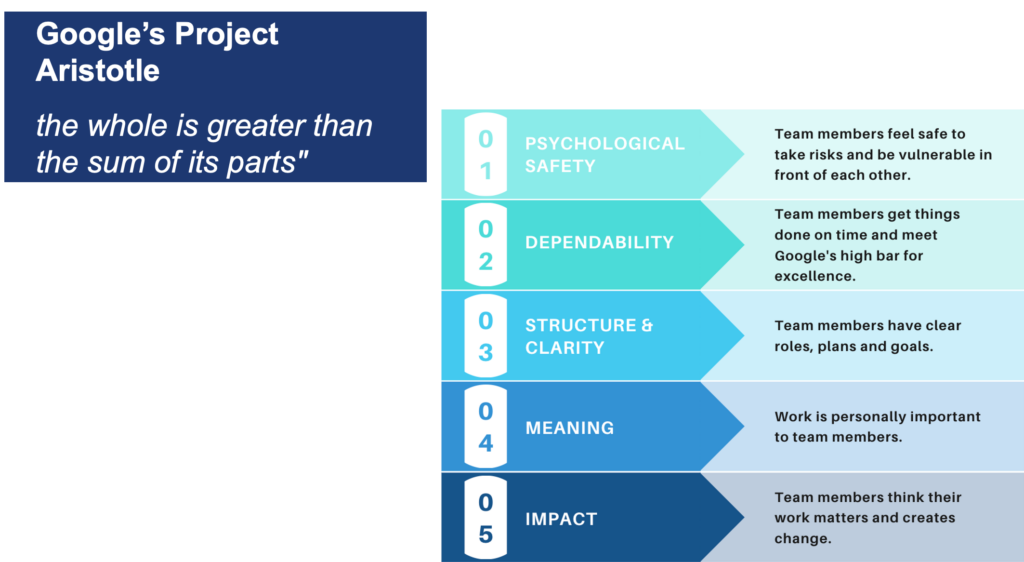
“No one wants to put a work face on when they get to the office.
No one wants to leave part of their personality and in a life at home. But to be fully present at work to feel psychologically safe.
We must know that we can be free enough sometimes to share the things that scare us. Without fear of recriminations. We must be able to talk about what’s messy or sad to have hard conversations with colleagues who are driving us crazy.
We can’t be focused just on efficiency.”
New York Times, based on Google’s Project Aristotle
Psychological safety and collaboration
Psychological safety is the most important foundation that you need to build in your team.
The term “psychological safety” was created by Harvard Business School professor Amy Edmondson.
Psychological safety is when a person knows and feels that they will not be punished or humiliated for speaking up with ideas, questions, concerns, challenges or mistakes.
Without psychological safety, your team members will lack trust in each other, be less supportive and feel less accountable for the team’s results. Here’s a super quick video I made for you on the key components of trust – it’s only a minute long!
Healthy challenge and collaboration in remote teams
Challenge is a good thing! We all take on challenges for ourselves such as to run a certain distance in a certain time, or study for a qualification.
Teams are brilliant when they are challenging each other in the right way!
Ideally, most teams should aim to be in the top right hand corner of the Challenge Culture matrix, shown in the visual below. There is high co-operation and psychological safety, and a high level of diversity of perspectives and ideas.
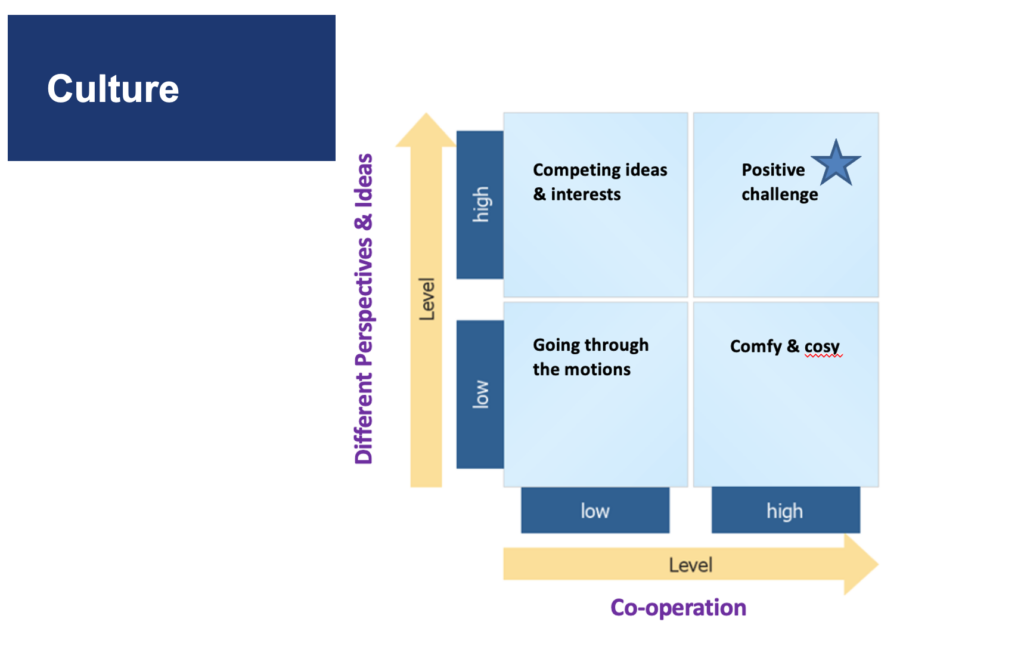
In order to challenge, however, we need to have psychological safety in place so that people feel it’s okay to do so, as I’ve mentioned earlier.
As a leader, role-model that you are willing to be challenged. Show that it’s fine to need time before you make a decision. As the leader, when you show your team that you are open and want to learn, you show that it’s ok for them to do the same. And proactively ask great questions, such as these, to create real opportunities for your team to challenge:
- How do you think we can make this better?
- What would it take for you to be really excited about this?
- What would you do differently?
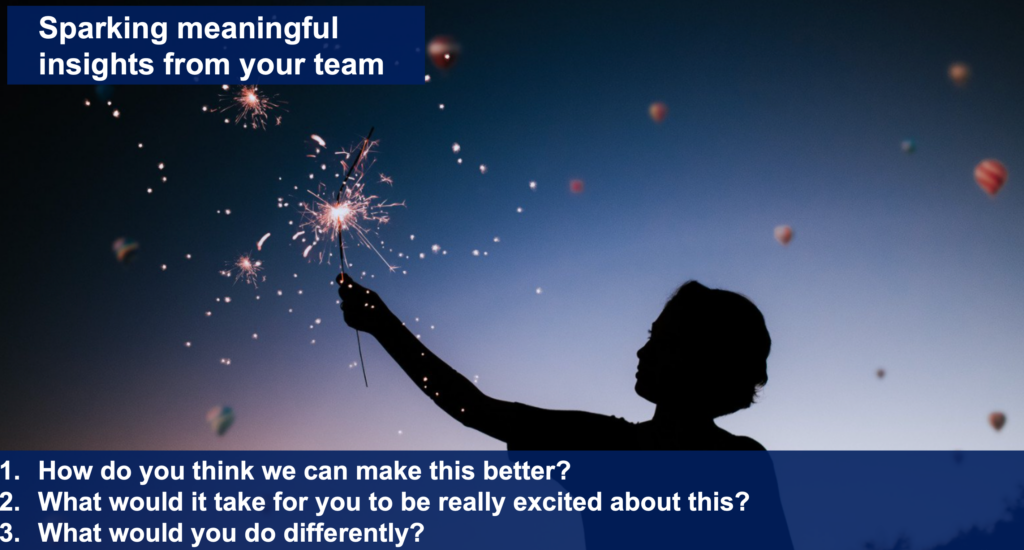
You’ll also find my article here on managing different perspectives and challenging conversations in groups helpful.
When collaboration gets tough
Question: What do you do when challenges arise?
Answer: Keep collaborating and work even harder at it!
Some projects have some challenging phases. This may be where people don’t agree, tension is high, or people fall out because something’s gone wrong. Keep collaborating. Keep the emotional intelligence high. Don’t take it personally when collaboration feels tough! This is when collaboration really counts the most.
Practical tips for leading collaboration in remote teams
The bigger the group, the more likely people are to stand back from collaborating. This is called the Ringelmann effect, when the greater the number of people, the less likely we are as individuals to take responsibility, and to contribute.
If you have a big group and you want to get people collaborating, have members work in small groups.
We also tend to collaborate more with people we know and like, but instead we should also be challenging ourselves to look for people who can give us some of that creative challenge, who can bring something different to our perspective.
Make sure you also think through:
- Whether or not true psychological safety is evident, and how you will act upon what you find to make it better if that’s what’s needed
- When to / when not to collaborate
- The logistics of your team’s virtual working environments
- How to put effective communication channels in place
- How you’ll ensure that meetings are interactive and have a purpose, and that only the people who need to be there attend meetings
- The process for making and communicating decisions
- Creating space for the exchange of knowledge
- Your strategy for keeping your team members motivated and engaged
- How you will make yourself visible and accessible to your team, and how they might do the same for the benefit of themselves and their colleagues
- How you will innovate, find and solve problems together
- What tools, processes and platforms you’ll use
Next steps
If you’re interested in improving your online team meetings, I’d love you to come and join me in my free, private Facebook Group, Idea Time for Workshop Facilitators.
As well as a fantastic community of likeminded people, you will get access to free online meeting training, tools, techniques and time savers.
If you lead remote meetings via Zoom , click here to get my free Supercharge Your Virtual Engagement on Zoom Video Course.
If you’d like to book us to deliver some professional online meeting facilitation for you and your team, or would like a one-to-one virtual training and coaching session, you can find out more about what we do here, or contact me direct using the form below and I’ll get straight back to you.
Hope to hear from you in so that we can chat about all things collaboration, remote teams, online meetings and leadership!

